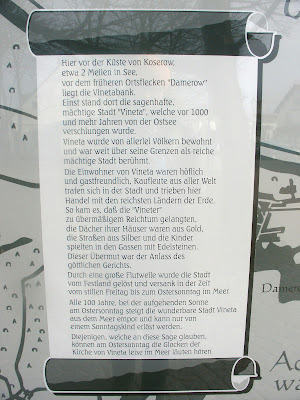The station names of Berlin's public transport network are various and are themselves linked to a network of stories behind them. Some have a literary background such as Onkel Toms Hütte (Uncle Tome's Hut, U3), others relate to persons of cultural and historic significance as Heinrich-Heine-Straße (U8), Mendelssohn-Bartholdy-Park (U2), and Kaiserin-Augusta-Straße (U6) and some sound particularly funny in other languages such as Wedding (S 41/42).
In the northern part of the city there is a district where the stations are all in some way or other related to northern Germany and Europe with Amrumer Straße, Osloer Straße (U9), and Bornholmer Straße (S 1/2/8) amongst them.
Another one of them is called Vinetastraße (U2) where I recently found myself wondering who or what Vineta was. At the age of intelligent telephones I immediately found the answer online.
What was more interesting, however, was, that only a few days later I came across the name a second time: not at a Berlin public transport station but in Koserow at the Baltic coast. And there the story of Vineta was far better told than any online resource could have ever done - including the sea climate and the rough weather.
Legend has it that Vineta was a very rich and powerful city two miles from today's coastline (the story reads a little like the legend of Atlantis): the roofs of its houses were made of gold, the streets were made of silver and the children played with gems and jewels. This abundance of prosperity and wealth brought about a divine tribunal and ultimately an enormous flood wave broke the city grounds loose from the mainland: the city sank into the sea between Good Friday and Easter Sunday.
Every hundred years, however, Vineta raises from the sea at sunrise and can only then be redeemed by a true Sunday's child. Those who believe in the legend will hear the bells of Vineta's church ring at Easter Day. So if you are at the Baltic coast during Easter: think about a detour to Usedom and Koserow.
(Ironically and as was expected, the story has been turned into a merchandising strategy of its own with a Vineta Festival, a Vineta holiday resort and other local Vineta industries).
Hans Bosse tells Vineta's story in a poem.
And below is the view at the sea where Vineta used to be.







nice post! I love little secrets like this. I wonder why they chose to name the station/street Vineta though.
ReplyDeletethanks a lot! the street at this station is also called "Vinetastraße" and belongs to a whole district of streets with Baltic coast names; and this name is certainly the most beautiful and 'legendary' of them - I assume that might be the reason why they chose the name?
ReplyDelete